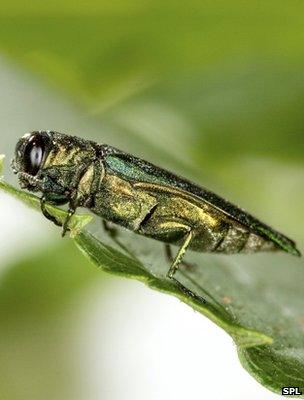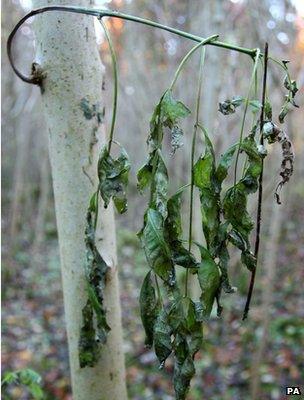Emerald ash borer beetle on the march across Europe
- Published

The arrival of EAB from the US has raised fears about the future of ash trees in Europe
An invasive species of beetle that has killed tens of millions of ash trees in North America could "spread unhindered" across Europe, researchers have warned.
The emerald ash borer, first recorded in the Moscow area in 2007, has become established in surrounding broadleaved woodlands, they observed.
The pest, which is expected to cost the US economy $10bn, has spread up to 25 miles each year, the team estimated.
The findings of the survey have been published in the journal Forestry, external.
The team of two UK and two Russian scientists found that the emerald ash borer (EAB) population had spread 146 miles (235km) west of Moscow and 137 miles (220 km) south of the Russian capital city.
In their paper, the team described EAB (Agrilus planipennis) as a "major threat to Fraxinus excelsior (European ash), and south of Moscow, where the beetle has become established in natural broadleaved woodlands in which F. excelsior is a major component, many of the ash trees are suffering severe dieback and mortality".
They added: "The abundance and almost continuous distribution of F. excelsior in these woodlands means that A. planipennis now has the opportunity to spread unhindered on a broad front to other countries in Europe."
Enemy within
The beetle is native to north-east China, the Korean peninsula, Japan, Taiwan, Mongolia and the Russian Far East.
The beetles' larvae feed on the surface layers of the wood of a tree, external, cutting off vital supplies of nutrients and water, causing branches and eventually the whole tree to die.
Although the adult beetles only live for a matter of weeks, an individual female can lay in excess of 200 eggs during their short lives but the average is estimated to be in the region of 30-60 eggs.
While native Asian ash trees appear to have co-evolved resistance to the EAB, US native ash species, such as the green ash (F. pennsylvanica) and white ash (F. americana) have no such resilience, resulting in devastating consequences.
Since the first recorded case of an EAB infestation in Michigan back in 2002, the invasive alien species has spread rapidly through 19 US states and two Canadian provinces, leaving a trail of devastation in its wake.
The researchers wrote: "The beetle has killed tens of millions of trees over the past 10 years and has raised concerns over the future of ash in North America.
"The cost to the US economy over the 10-year period from 2009 to 2019 - in terms of tree removal and replacement alone - is expected to exceed $10bn."
Whether a similar fate awaits European ash trees remained uncertain at this stage, explained co-author David Williams, an entomologist from Forest Research, the scientific arm of the UK Forestry Commission.
During the summer, Dr Williams and colleague Dr Nigel Straw spent two weeks in and around Moscow to assess the impact and spread of EAB in the area.
Dr Williams told BBC News that previous research suggested that an individual beetle would not fly more than six miles (10km) during its lifetime.

Europe's ash trees are already reeling from the impact of ash dieback
Yet the team, in their assessment, found evidence that EAB was spreading by up to four times that distance.
"There is evidence that the species is riding on vehicles, which is why it is moving long distances," Dr Williams observed.
"If it is travelling long distances, it is dependent on a host tree being available for it to jump on to."
"To the south of the city, European ash is a component of the natural woodlands. Now that it is established in these woodlands, it is difficult to judge how quickly it is likely to move."
He added that it was difficult to quantify the size of the emerald ash borer population that had become established in the woodlands south of Moscow.
"Trying to find signs and symptoms of EAB damage is unbelievably difficult in the early stages," Dr Williams explained.
"It does seem to be from our observations that it [is] much harder to spot signs and symptoms of EAB damage in European ash than in North American species of ash.
"So the fact that it has reached this almost continuous forest of ash into Europe through Belarus and Ukraine is going to [make it] difficult to track its movement."
Touch wood
The UK is more than 1,500 miles from Moscow, and the Forestry Commission predicts that it is likely to be "many years" before the pest reaches these shores under its own steam.
However, a spokesman added: "Regulations are in place to minimise the risk of its accidental introduction in trade and transport, and we are assessing whether more needs to be done to further reduce these risks."
He added that the UK and the EU were currently drafting Pest Risk Analyses, external on EAB.
In addition, tree health experts were developing a contingency plan in case there was an EAB outbreak in the UK.
The spokesman said that it would follow the same approach used to tackle an outbreak of Asian longhorned beetle in Kent in 2012.
And there was a Europe-wide network, known as Fraxback, that allowed scientists across the continent to share their research and findings.
Although its efforts were focused on tackling ash dieback, it could provide information that could be used in terms of slowing or halting the spread of EAB.
Dr Williams said that during his time in the Russian woodlands, there were signs that some trees may have a degree of resistance to EAB infestations.
"European ash is supposed to be much more closely related to Asian ash species than North American species, so that resistance that Asian ash species has to EAB could well be part of genetic make-up of European ash," he suggested.
"There was certainly some evidence within Moscow itself. We did not find many European ash but when we did find them, half were looking perfectly healthy.
"Perhaps more interestingly, when we moved south into the forests where European ash is much more common, there was a much higher degree of variability in the trees' canopy condition.
"This is the opposite of what you find in North American species of ash. When it is attacked by EAB, the dieback is so obvious it is startling.
He added: "This suggests that it is perhaps not as susceptible to the beetle as North American species."
- Published27 October 2012
- Published17 December 2012
- Published21 October 2013